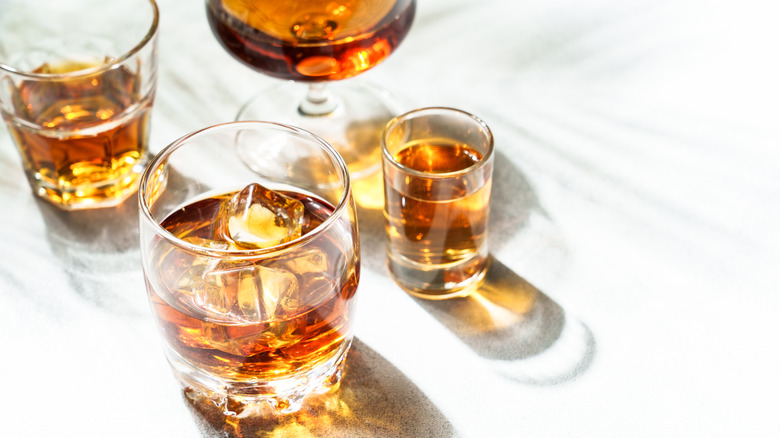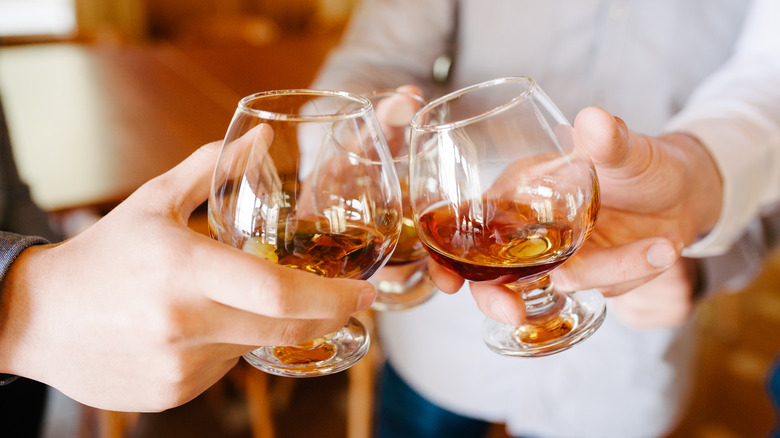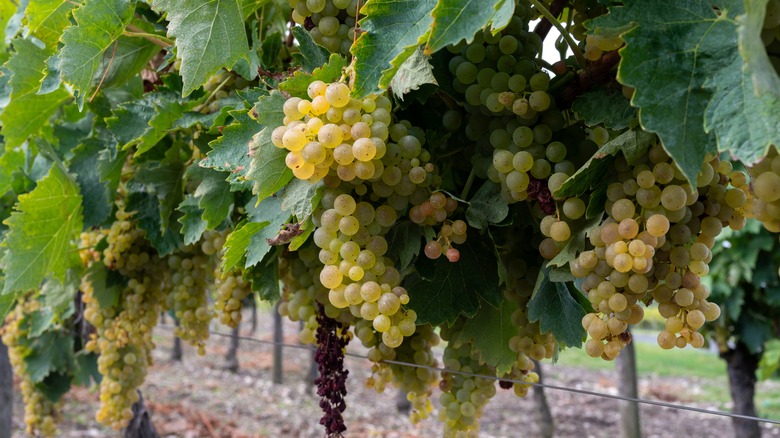Grande Vs Petite Champagne: The Difference Between Cognacs
Like Champagne, Cognac is named for a specific region in France. Though both come from grapes, the two are otherwise quite distinct from one another. Cognac is a double-distilled brandy created mostly from Ugni blanc grapes in six defined growing regions of Southwest France. Within those six appellations, also known as crus, two stand out as the most prestigious: the Grande Champagne and Petite Champagne.
The six regions designated for growing the roughly 190,000 acres of grapes for Cognacs perch near the picturesque French town of Cognac. That includes the other four crus: Fins Bois, Bons Bois, Borderies, and Bois Ordinaires. Each has its own defining soils and topography, but no Cognacs receive more praise than ones emerging from Grande Champagne and Petite Champagne. The somewhat confusing names of those two crus apparently arose from having similar characteristics to soils in the northeastern Champagne region, namely a notable chalkiness that contributes to the light floral and fruit flavors in the resulting Cognacs.
All Cognacs, regardless of where they originate within the six crus, must adhere to meticulously specific requirements, including double copper-pot distillation of specific grapes, plus two years of cask aging in oak wood from France's Limousin or Tronçais forests. Given the identical process, you'd imagine the two most elite Cognac regions, which share similar soil composition, would produce almost indistinguishable results. But even the slightest factor can noticeably impact the final bottles of Cognac.
Grande Champagne, the Premier Cru
Grande Champagne, also referred to as the Premier Cru, is well known for producing the most coveted Cognacs available. It's even located within the town of Cognac, home to several top-ranked Cognac brands such as Hennessy, Hine and Martell. The hilly terrain surrounding this area allows plenty of water to flow through the vineyards, which are planted in Cognac-friendly soils of shallow limestone, clay, and chalk.
Though Grand Champagne is only responsible for about 17% of annual Cognac production, its "eaux-de-vie" are generally considered superior to all others. The term eaux-de-vie translates as "waters of life," and it describes brandy before it's been through the aging process. It's therefore the defining core from which all brandies, including cognacs, emerge. The longer it ages, the more distinct the flavors become. Cognacs from this region generally present as fruity and floral, with plenty of finesse.
Eaux-de-vie from the Grand Champagne cru generally take much longer to peak, resulting in some of the most expensive Cognacs with the longest aging periods. This places many Cognacs from this region squarely within the most desirable, and most expensive, types of Cognac, the XXO category that age at least 14 years. You'll be able to identify Cognacs from the Grande Champagne region by labeling such as "Hine XO 1er Cru Grande Champagne Cognac," which reveals the brand; the age; that it's a "first growth" ("1er Cru"), or superior-quality, vineyard; and the exclusive content of eaux-de-vie from the Grande Champagne region.
Petite Champagne, light and floral
The Petit Champagne growing region makes it mark on Cognac in a gentler, lighter way, but it's still very similar to Grande Champagne in its penchant for fruity notes, highlighted especially by delicate floral overtones. It's a definite sidekick to its more touted big brother, maintaining the same reputation for high quality and a taste that lingers. This grape-growing region is considerably larger than Grande Champagne, and it covers a higher percentage of production at 22%. The soil composition is similar as well, though the hills are more sparse and the region hosts meandering streams producing humidity that benefits the grapes.
Some Cognac devotees prefer the lighter nuances in Petit Champagne offerings, especially as they're adaptable to blending. This opens limitless possibilities for nuanced brandies in a wider price range. A favorite blend is the duo of the top two, the Petit and the Grande Champagnes. It even gets its own Cognac designation: Fine Champagne. It doesn't have a growing region of its own, but instead gets a Controlled Appellation of Origin distinction, specifying that it's made from at least 50% Grand Champagne and the balance in Petit.
Some Cognac brands, including the excellent Rémy Martin, use fruit exclusively from the Petite and Grande Champagne regions, guaranteeing the quality of the eaux-de-vies and the penchant for aging well over time. Some of Rémy Martin's most iconic products are Fine Champagne blends of the two.


